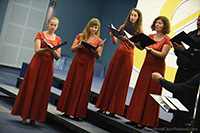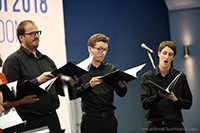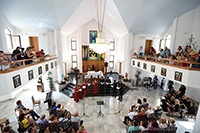Programme
| Title | Composer | Lyrics |
| COMPETITION SECTION | ||
| Mori, mi dici (Die, you tell me so) | Alessandro Scarlatti (1660–1725) | |
| Verlorene Jugend (Fünf Gesänge Op. 104, No. 4) Lost Youth (Five Songs Op. 104, No. 4) |
Johannes Brahms (1833–1897) | Josef Wenzig (1807–1876) |
| Abba – Amen | Petr Eben (1929–2007) | Karl Rahner (1904–1984) Erich Przywara (1889–1972) Friedrich Rückert (1788–1866) |
| Aliluja | Zapro Zaprov (b. 1947) | |
| SACRED SECTION | ||
| Sanctus (Missa Surge propera) | Francisco Guerrero (1528–1599) | |
| Sing Joyfully | William Byrd (1538–1623) | Psalm 81 |
| Psalmus 133 (Psalmi peregrini, No. 4) | Petr Eben (1929–2007) | Psalm 133 |
About
Capella Silentium was founded in 2009 with the aim of exploring the forgotten beauty of a cappella choir literature, and to bring alive its various eras and styles. Capella Silentium is one of the few a cappella vocal ensembles with individual and scarce profile: its programs are thematic, focusing on a special era or phenomenon of the history of music. Its repertoire comprises music from the early renaissance polyphony to contemporary music, and not specialized on one era or style. In 2010 in Vienna, the choir attained the special prize for the best performance of the obligatory musical piece on the Schubert Choir Competition, where they were also qualified for the round of the best choirs. In 2012, they finished second in mixed choir category in Rimini, and they were awarded the special prize for the best chamber choir.
Balázs Ferenc Csernyik graduated in Music Education, Choral Conducting and Church Music
from Franz Liszt Academy of Music.
Mátyás Mészáros joined the choir in 2013 as a singer. He is studying Choral Conducting
at the Franz Liszt Academy of Music in Budapest.
They both have been the conductors of the choir since 2016.
Budapest is the capital city of Hungary, it is cited as one of the most beautiful cities in Europe. There are some famous cultural institutions as the Hungarian State Opera House and Franz Liszt Academy of Music, many notable monuments including the Hungarian Parliament and Buda Castle, and some famous landmarks including St. Stephen’s Basilica and Heroes’ Square.









